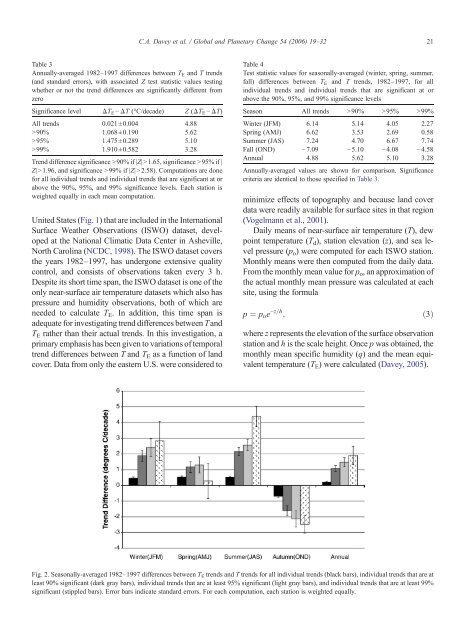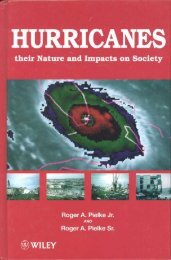Equivalent temperature - Climate Science: Roger Pielke Sr.
Equivalent temperature - Climate Science: Roger Pielke Sr.
Equivalent temperature - Climate Science: Roger Pielke Sr.
You also want an ePaper? Increase the reach of your titles
YUMPU automatically turns print PDFs into web optimized ePapers that Google loves.
Table 3<br />
Annually-averaged 1982–1997 differences between TE and T trends<br />
(and standard errors), with associated Z test statistic values testing<br />
whether or not the trend differences are significantly different from<br />
zero<br />
Significance level ΔTE−ΔT (°C/decade) Z (ΔTE−ΔT)<br />
All trends 0.021±0.004 4.88<br />
N90% 1.068±0.190 5.62<br />
N95% 1.475±0.289 5.10<br />
N99% 1.910±0.582 3.28<br />
Trend difference significance N90% if |Z|N1.65, significance N95% if |<br />
Z|N1.96, and significance N99% if |Z|N2.58). Computations are done<br />
for all individual trends and individual trends that are significant at or<br />
above the 90%, 95%, and 99% significance levels. Each station is<br />
weighted equally in each mean computation.<br />
United States (Fig. 1) that are included in the International<br />
Surface Weather Observations (ISWO) dataset, developed<br />
at the National Climatic Data Center in Asheville,<br />
North Carolina (NCDC, 1998). The ISWO dataset covers<br />
the years 1982–1997, has undergone extensive quality<br />
control, and consists of observations taken every 3 h.<br />
Despite its short time span, the ISWO dataset is one of the<br />
only near-surface air <strong>temperature</strong> datasets which also has<br />
pressure and humidity observations, both of which are<br />
needed to calculate T E. In addition, this time span is<br />
adequate for investigating trend differences between Tand<br />
T E rather than their actual trends. In this investigation, a<br />
primary emphasis has been given to variations of temporal<br />
trend differences between T and TE as a function of land<br />
cover. Data from only the eastern U.S. were considered to<br />
C.A. Davey et al. / Global and Planetary Change 54 (2006) 19–32<br />
Table 4<br />
Test statistic values for seasonally-averaged (winter, spring, summer,<br />
fall) differences between TE and T trends, 1982–1997, for all<br />
individual trends and individual trends that are significant at or<br />
above the 90%, 95%, and 99% significance levels<br />
Season All trends N90% N95% N99%<br />
Winter (JFM) 6.14 5.14 4.05 2.27<br />
Spring (AMJ) 6.62 3.53 2.69 0.58<br />
Summer (JAS) 7.24 4.70 6.67 7.74<br />
Fall (OND) −7.09 −5.10 −4.08 −4.58<br />
Annual 4.88 5.62 5.10 3.28<br />
Annually-averaged values are shown for comparison. Significance<br />
criteria are identical to those specified in Table 3.<br />
minimize effects of topography and because land cover<br />
data were readily available for surface sites in that region<br />
(Vogelmann et al., 2001).<br />
Daily means of near-surface air <strong>temperature</strong> (T), dew<br />
point <strong>temperature</strong> (T d), station elevation (z), and sea level<br />
pressure (p o) were computed for each ISWO station.<br />
Monthly means were then computed from the daily data.<br />
From the monthly mean value for po,anapproximationof<br />
the actual monthly mean pressure was calculated at each<br />
site, using the formula<br />
p ¼ poe −z=h ; ð3Þ<br />
where z represents the elevation of the surface observation<br />
station and h is the scale height. Once p was obtained, the<br />
monthly mean specific humidity (q) and the mean equivalent<br />
<strong>temperature</strong> (TE) werecalculated(Davey, 2005).<br />
Fig. 2. Seasonally-averaged 1982–1997 differences between TE trends and T trends for all individual trends (black bars), individual trends that are at<br />
least 90% significant (dark gray bars), individual trends that are at least 95% significant (light gray bars), and individual trends that are at least 99%<br />
significant (stippled bars). Error bars indicate standard errors. For each computation, each station is weighted equally.<br />
21














